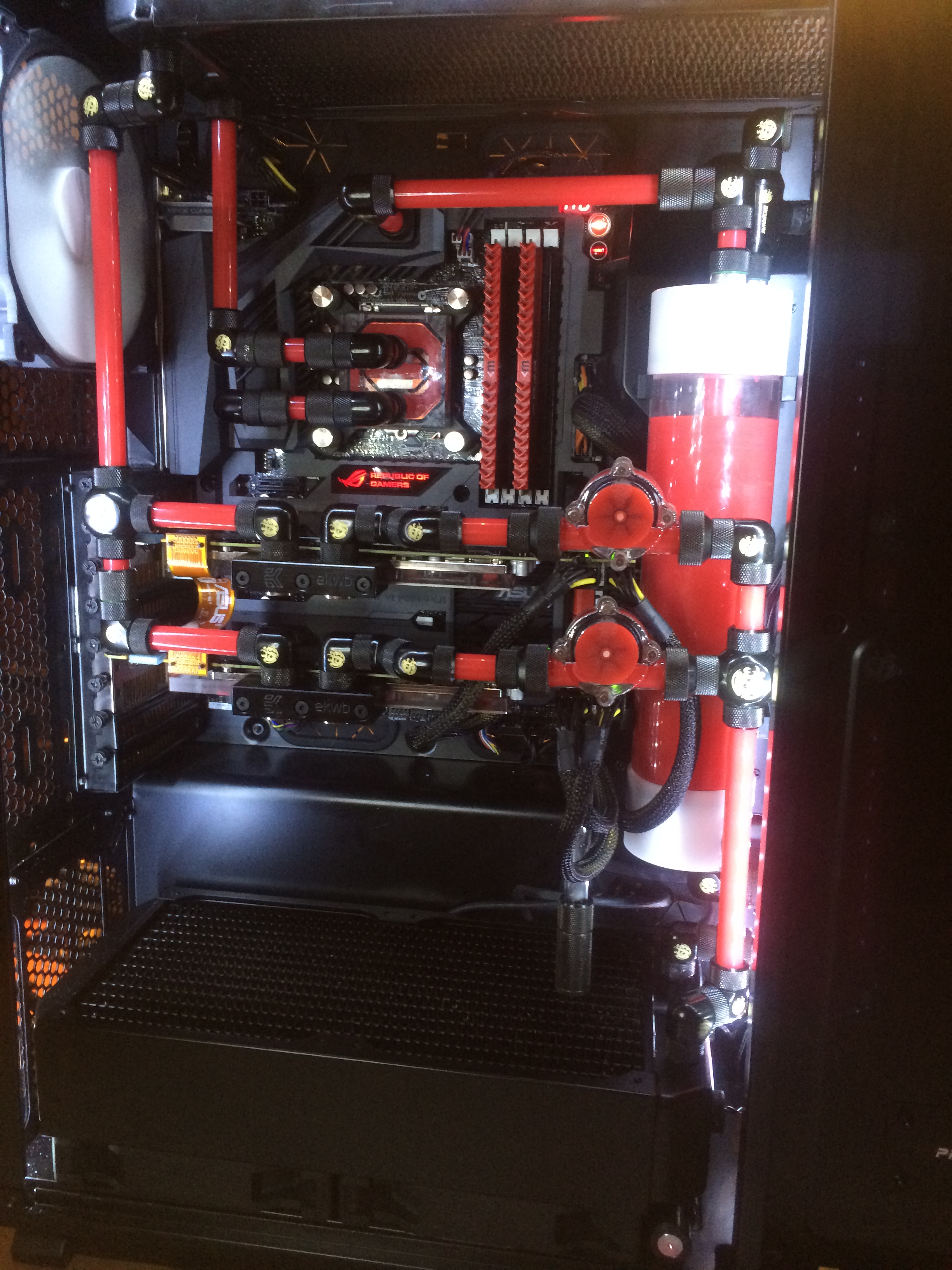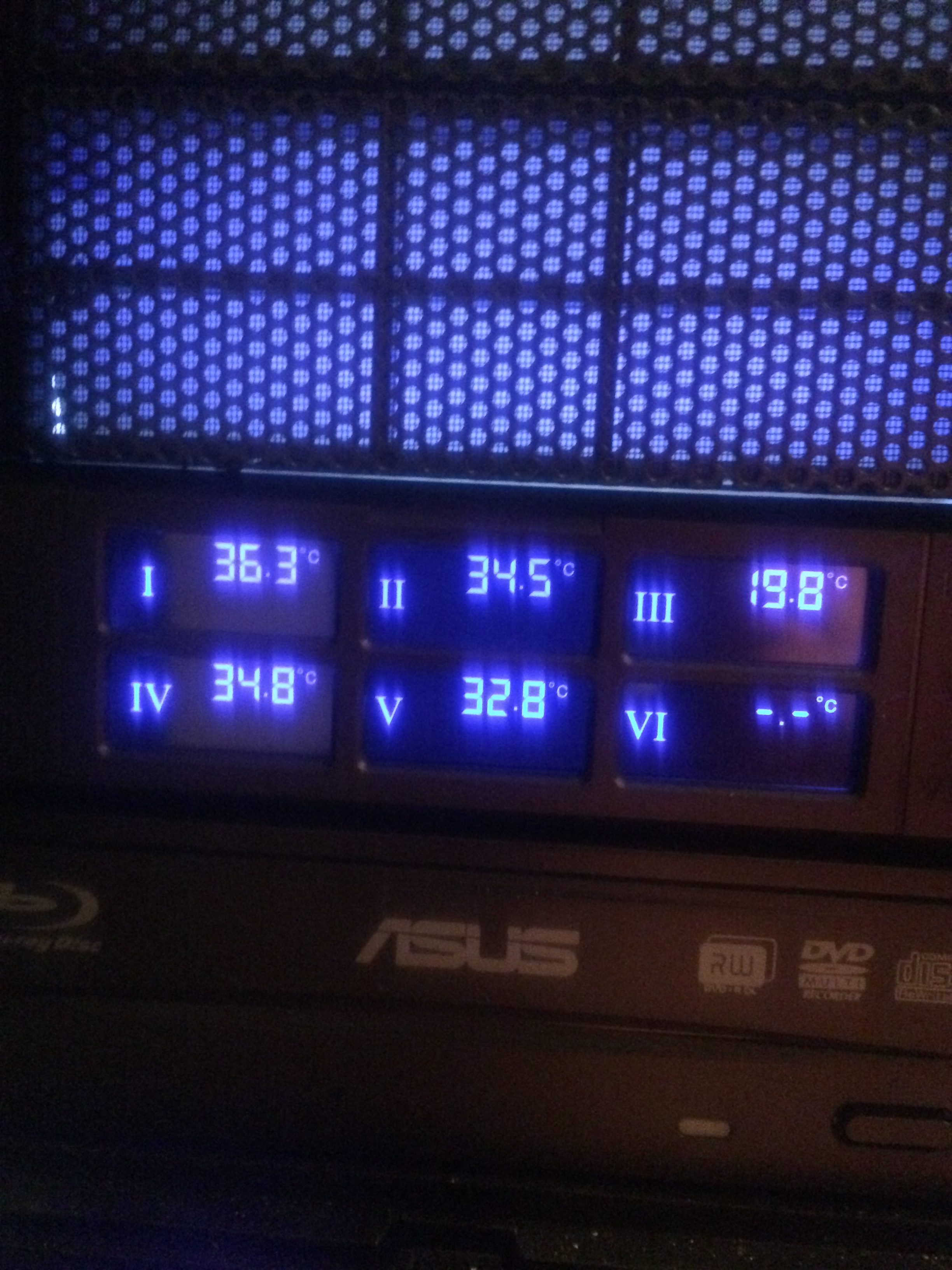weak pumps? ..... I have no maintenance on my CLC and i have an overclock i7 3690x at a nice 24 C temp. Yup.. it is so weak. Full load I don't even pass 58 C temps.
1. When the word "weak" is used on a pump, it refers to the head or pressure as well as the amount of flow it can produce. The H100i pumps a meager 0.11 gpm and pulls just 2.2 watts.....
http://www.overclock.net/t/1371863/corsair-h100i-max-flow-rate-test-video-result
check any water cooling guide and you'll see no recommendations below 1 gpm.
The Swiftech OLC does well over 1.0 gpm and not only does it have enough oomph to push thru a CPU water block , it has enough oomph to push thru two GFX card water blocks and an additional radiator.... A typical D5 pump will top out at 5.5 psi and up to 4.25 gpm and 22 watts .... 10 times more power than the H100i
https://martinsliquidlab.wordpress.com/2011/04/03/koolance-pmp-450-d5-vario-pump/
When you use the words strong and weak they are relative terms.... by definition the one who has the bigger number is "stronger" than the other and the one that pushes less is "weaker" than the other.
I use a Swiftech 35x2, (52 watts, max 12.4 psi, 4.5 gpm max) ... 24 times stronger than a H100i
So yes,
unequivocally,..... a pump that can produce a maximum of 0.11 gpm and pulls just 2.2 watts is considered "weak" when compared against ones that can do over 4 gpm... that's 36 times greater flow and 10 times as much power ....or, flow wise, like comparing two weightlifters where one can bench 10 pounds (weak) and the other 360 lbs (strong) or , power wise, one can bench 36 pounds (weak) and the other 360 lbs (strong)
galvanic corrosion from mixed metals? really? yea, I guess when you spring for crap CLC. I have never had any corrosion from and CLC that I have bought.
2. Yes, galvanic corrosion, it's associated with "science", particularly chemistry. Like the old saying "Obey Gravity; it's a law". They call them "laws of science" because there is no way around them. You can slow it down but not stop it. If you have ever owned a boat you would know about "zinc anodes" also called "sacrificial anodes" . You put these on a boat and they sacrifice themselves... they erode away so that your props and other metal components exposed to water do not erode away. As for your good / crap CLC categorization can you perhaps explain how the aluminum in a "crap CLC" differs from the aluminum in your CLC ?
Here's a picture of a user's custom water block where the user mixed aluminum and copper. The aluminum eroded away and all the gunk wound up clogging the water block. The was no external indication of this process as all the evidence is inside the block.
In a CLC you have an aluminum radiator and a copper block....creating a galvanic circuit..... electrons will flow from the aluminum to the copper as copper is the more "noble" metal. Inhibitors can slow the process but they lose their effectiveness over time. You are in no position to know if you have had any galvanic corrosion in a CLC simply because it is a CLC with the first "C" standing for
closed .... it doesn't come apart for inspection. So unless you have a picture to show us of your water block disassembled as shown above, you are in no position to speak to the subject.
If you want to learn about galvanic corrosion read this
https://martinsliquidlab.wordpress.com/2012/01/24/corrosion-explored/
It's science, it's real, and yes it's still the law. Again, one can use corrosion inhibitors but they lose their effectiveness over time. the fact that you can not flush, clean and add more inhibitor to a CLC is one of it's primary downfalls.
If you swap out the cooler every 18 months, you are doing it wrong. Maintenance cycle is yearly on water cooling not to mention cleaning all pipes, connectors, pumps, rads from dust, and blocks. If you don't do any of that every year, you are doing it wrong.
3. Interesting comment from someone who has a CLC where it is impossible to do the very thing you say is required every year. How often are you cleaning your "pipes, connectors, pumps, rads from dust, and blocks" tho I am real curious how dust gets inside the loop. What is the scientific principle behind mixed metals CLCs never having to do any of this for 5 years and a yet custom loop containing superior components, better engineered coolants, noble metals all around and acrylic pipe (instead of plasticizer containing flexible tubing) has to do it every year ?
Does the CLC manufacturer have "magic coolant" that the defies the laws of science in there ?... maybe they get it from the same guy who sold Jack his magic beans. How does the CLC's coolant, corrosion and scale inhibitors, biocides, etc., manage not to deteriorate within the closed system over time and yet the engineered coolant in the custom loop is completely shot after just 1 year ?
Show me where it says that I have to change my engineered coolant every 12 months ?..... I have an extremely low potential galvanic circuit in my loop because there is no cheap, thermally inefficient, aluminum radiator that serves double duty as a sacrificial anode. From the product page
http://mayhems.co.uk/store/red-1ltr.html
... system working life of about two years, of which is due to a design that is intended for prolonged use.
I have spoken with the product developer and they report that they have found no significant deterioration of the product when in use over 3 years. The 2 year recommendation is conservative.
I do have a system drain on the lower rad and about every 6 months I take a small sample and filter it for any residue .... none found to date. I used about 1.8 liters to fill the loop so have plenty of left over coolant to add. Attach a quick-disconnect, open a valve take an ounce ... takes about a minute, than another minute to top it off tho this step is merely aesthetic and affects only the level in the 10" tall reservoir. There is no scale or anything; if there was it would be readily visible with the "clear" acrylic tubing, the "clear" acrylic GPU blocks or the "clear" acrylic CPU block. Any decrease in cooling efficiency would also be immediately observable via the LCD display of the (6) temperature probes in the system.
Any gunk in the system would be readily visible.... the CPU block, the 2 water blocks , all the tubing is clear acrylic
Or results of which readily viewable on the temperature readouts
I should note that during office hours, all the system fans shut down unless I'm doing something demanding in AutoCAD, in gaming the fans turn on but they start at 350 rpm and never go over 850 rpm , a speed at which they are completely inaudible....as compared to a CLCs 68 dbA which is comparable to a vacuum cleaner
http://www.kitguru.net/components/power-supplies/zardon/seasonic-snow-silent-750w-psu-review/6/
But the issue here I thought is not my loop against CLCs.... it's:
Absolutely.
1. CLCs that are more expensive and simply do not perform anywhere near less expensive air coolers.
Which gets better CPU temps ? The H100i is inferior to the D-15 by 2C ?
Which is louder ? The H100i is 12 times louder than the D-15, the H100i is inferior by 35 dbA
Who's cheaper ? The D-15 is cheaper.
Which presents least risk ? The H100i can do this and the D-15 can't.
http://forum.corsair.com/v3/showthread.php?t=126667
More importantly , why pay $120 for a CLC like the H100i GX with a extremely weak pump, aluminum rad, mixed metals and an inability to do that 1 year maintenance you said was absolutely required for water cooling that can do just the CPU, when for just $20 more I can get an OLC like the H220-X that has all copper components, quite a hefty pump, no mixed metals, guarantees no maintenance but allows me to do it if I want to, AND !!! .... it allows me to open the loop and cool RAM, 1 or 2 GFX cards, add radiators and whatever else without a worry ?
2. Finally, what is the logic where, with the CLC route, you have product lines of 2 (even 3) x 120mm worth of rad for an 84 watt (130 OC) CPU and yet EVGA only allots a 120mm rad for a 250 - 300 watt GFX card ?
If we need a 2 x 120mm H100i to do that 84 - 130 watt CPU, that's 65 watts per 120mm. Taking that to the 980 Ti 's 277 watts (Gigabyte's 980 pulls 342 watts, imagine where their Ti will be)
http://www.techpowerup.com/reviews/NVIDIA/GeForce_GTX_980_Ti/29.html
277 watts / 65 per 120mm = 4.26 ... Where's the 4 x 120mm radiator ??
The approach taken by Asus makes far more sense.
1. A user can run the card on air and then later move to water.
2. A user can use a custom loop or a even Swiftech H240-X
3. If they then want to move to water (or right from the getgo) one $85 radiator, cupla feet of tube and a few fittings and you're done..... nice and neat, 1 loop instead of 3 resulting in a much cleaner looking, more efficient and quieter installation with 3+ times the water flow of the 3 loops combined..
EVGA SLI method w/ H100i - 3 pumps, 3 blocks, 3 loops, 4 x 120mm rad in 3 rads
Asus SLI method w/ H240-X - 1 pump, 2 rads, 3 blocks, 6 x 120 rad in 2 rads + the extra fans / heat sinks on the GPU
In the later instance you get twice the cooling for the GPUs, three times the water flow, far less complexity a much cleaner looking installation.... and no noisy 2700 rpm fans.

 .... w/ 3 kids and 6 figures in college debts
.... w/ 3 kids and 6 figures in college debts



